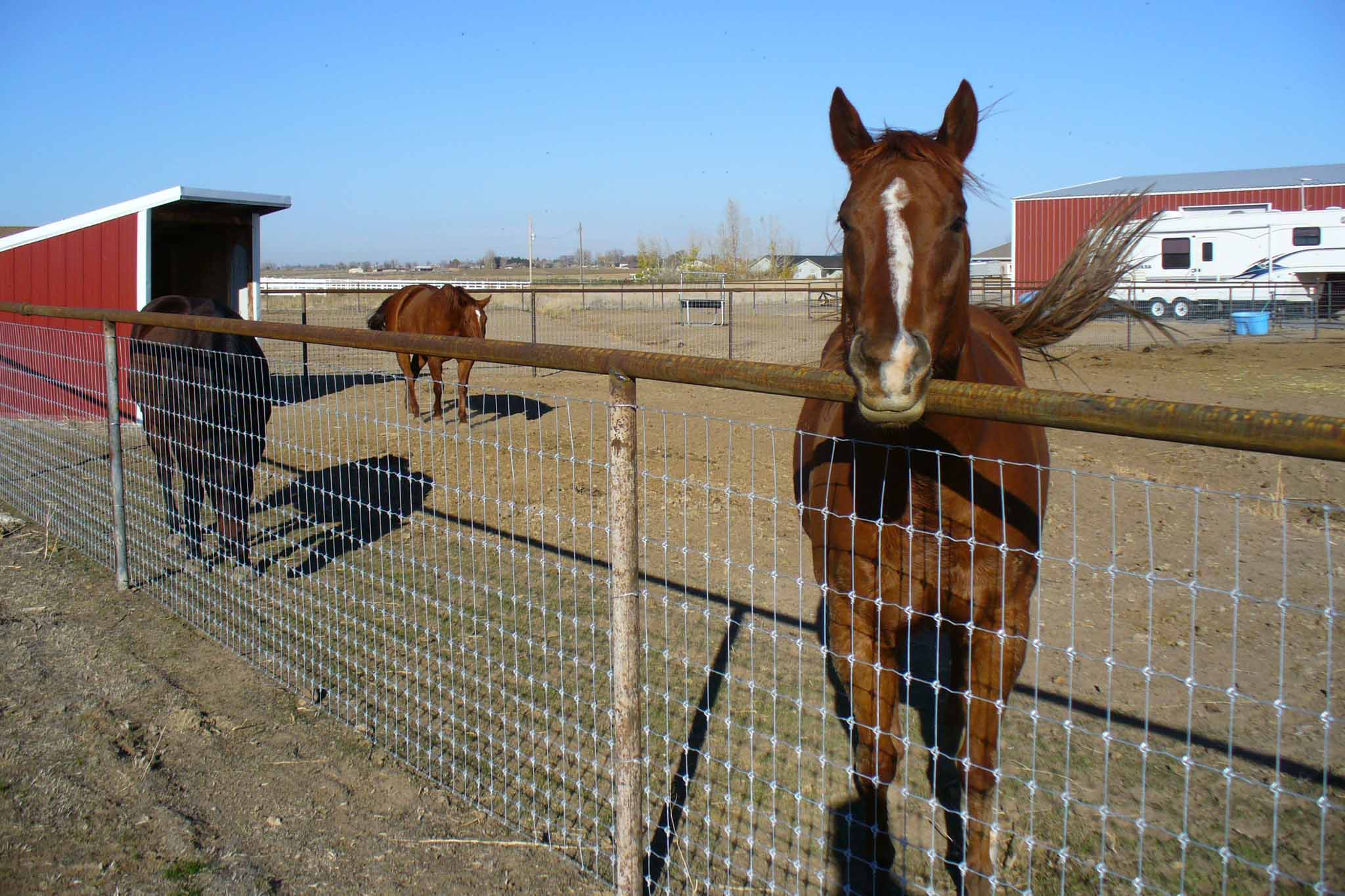Why is it my neighbor has his horse out in a field with old wire, old plows a couple of broken down cars, shards of glass and spikes sticking out of the ground but never gets hurt yet, my horse is in a padded stall and comes up lame?? Is it Murphy’s Law? Dumb luck?
Who knows what the real reason is, but it does seem like the horse you want to use is always the one that gets injured.
So how do we minimize the chance of injury to our friend the horse?
First, a little Psychology of the horse; Horses have their quirks first they are herd animals so if there are horses on the other side of the fence they want to be over there rather than alone. Second, they are fight or flight animals so if they feel trapped or contained, one of two things are going to happen- panic and thrashing, or fight and thrashing, either way, there is going to be some thrashing. Thirdly, Horses (believe it or not) are just like people. There are nice ones, easy going ones, high strung ones, mean ones and just plain pissy ones. So, your horse’s attitude has a lot to do with it.
What makes a good horse? Nope, not that special pink halter you bought at your last seminar, or that super bit the guy with the good-looking Stetson sold you… it’s time. Time is what makes a good horse, and let’s face it, none of us have or spend enough time with a horse. I’ve seen a lot of bad riders get stuff done on a horse because they ride the horse all the time. The horse understands them, they understand the horse and it works. Now, does this discount owner training? No, in my opinion, there should be way more owner seminars than horse seminars.
Horses are really pretty simple- feed me, respect me and talk to me in a language I understand. So what trainers need to do is teach owners to speak horse.
Unfortunately, most folks think a horse needs to learn to speak Owner and that doesn’t work so well.
Anyway, back to the point. In my humble opinion, there are two ways to make a fence horse safe, build the fence solid so that no part of the horse can get hung up in the fence or open enough and smooth enough that if the horse gets in the fence they can get out. So larger gaps sometimes are better than small gaps. If you can stick your hand in a hole and make a fist and not get it back out, your horse can get caught in it. The next thing to focus on is sharp edges or cut points etc. The third thing is traps. What I mean by traps is, if my horse puts all 1100 pounds of him/herself against the fence, will it give, and when it does give, will it give so much it deforms and grabs ahold of him/her? That is a trap. You see it happen on a lot with lightweight panels, a horse jumps up on the panel the panel collapses and traps the leg then the thrashing begins… INJURY follows shortly.
So first, evaluate your horse- old and wise or young and stupid, high strung or easy going and so on.
Second, evaluate your environment, open pasture with lots of feed and water and other horses or small corral with whatever I give him and horses in the corral next to him?
Third, evaluate how long the horse will be contained vs how much time you will get to spend with the horse, believe it or not they get bored. “A horse with purpose is a happy horse.”
Lastly, there is that deadly thing called budget… What can you afford? This is where it’s always tough, even for us that are in the business when it comes to our own fencing, $$$.
After 20 years of fencing, and a lifetime of horses here is what I like.
I like a nice open concept fencing with the minimum number of rails to contain whatever it is your trying to contain, goats need way more fence then old Buster my 22-year-old ranch gelding.
I don’t want to overpay for a bunch of fence just in case I decide to buy a buffalo someday, nor do I want to detract from the property. I just want to contain the critter. I also like at least a jag of solid rail fencing with a top rail close to where I need to tie stuff up, let’s face it, we all have that moment where we need to start catching and tying horses and they may not be able to be tied together. So, a 30-foot section of solid rail fencing next to the vet station is a godsend when things go awry, start catching and tying. I like most of my fence no higher than my arm pits and I am 5’8” that way I can lean on the fence and admire my stead. 😊 I like to use round material, as it eliminates sharp corners etc. it creates smooth lines, good looks and less chance of injury. The round pen size needs to be suited for what I am doing. If I am breaking colts then I want a small one so they cannot get their buck on (so to speak). If I am trying to train a horse to move and stretch I like no less than a 70 ft pen so they can get a good lope going. So, if I buy panels I can make it whatever size I want. 😊
If I have runs, I like to use solid fencing with a big gate on the end or a panel so I can get the tractor in there to clean out the runs (otherwise that is a lot of pitchforking for my wife 😊) I will actually use all panels a lot so I can take them all down, clean out and refill with material if needed.
“That’s Great Darren but we really don’t care what you like so what do we do?”
Here is my advice, don’t just call around and ask how much this fence is or that fence is. Truth is you may need several kinds of fence.
Perhaps in your pastures, you just need some 5-strand smooth wire fence just to contain them so they don’t wander off. (cost effective) (Tip: use Pipe posts for the corners) Then you need a nice solid corral, this is where you are going to catch and tie a horse, try to catch a horse that is hurt or contain a bronc if you end up with one etc. Then you will need a place to work your horse, a place where you will be spending time with your horse, a round pen so to speak. So, can you use light panels or heavy panels? Should it be solid fencing? Depends on the horse, and is that with cow or without cow 😊.
Does it depend on if you need to move it? Are you just riding the trained horses in there for exercise, then use a lightweight inexpensive good panel, if you are going to break colts then you need a lot more fence.
Lastly what is the look you are going for? Big and bold or clean and crisp or does it just need to do the job.
The point is there are lots of different kinds of fencing because there are lots of different uses and reasons to buy a fence. The most important thing is to consult a professional fencer not just your buddy.
A professional fencer is going to ask you all these questions so they know what you need, just like buying a car there is no one answer for everyone, some like more creature features, some just need to get from point A to point B.
There are new fencing materials available all the time. Try to buy something repeatable in case you want to add on. Learn how to install the fence properly or hire a professional installer. Fence is one of those things that even great materials can make a bad fence.
Obviously, panels are the easiest for the “do it yourselfer.” Many times, solid pipe fencing is about the same price as panels (installed)and it is a much heavier safer fence. A post and top rail with Stay-Tuff fencing is a good all-around fence to hold dogs, goats and your horse safely.
Finally, have a plan of what you are going to do with your animals and what kind of animals you plan on having. That will then determine your type of fencing and the budget you need to be looking at.
It will also help you determine how many panels/fence/corrals you need.
Lastly, as we always recommend, “build it just once, build it with Steel”.
Happy trails, pilgrims…


